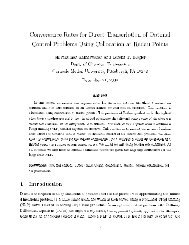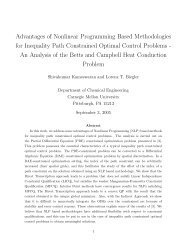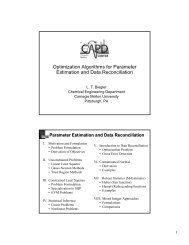MPEC Problem Formulations in Chemical Engineering Applications
MPEC Problem Formulations in Chemical Engineering Applications
MPEC Problem Formulations in Chemical Engineering Applications
Create successful ePaper yourself
Turn your PDF publications into a flip-book with our unique Google optimized e-Paper software.
etter understand<strong>in</strong>g of NLP-based solution strategies for MPCCs, it is essentialto consider the formulation of well-posed complementarity models. In thissection, we consider a systematic MPCC model<strong>in</strong>g strategy and apply it to anumber of widely applied process examples.To develop these concepts, we aga<strong>in</strong> caution that complementarity formulationsare nonconvex problems and may lead to multiple local solutions. Consequently,with the application of standard NLP solvers, the user will need tobe satisfied with local solutions, unless additional problem-specific <strong>in</strong>formationcan be applied. Despite the nonconvexity <strong>in</strong> all MPCC formulations, it is clearthat poorly posed MPCC formulations also need to be avoided. For <strong>in</strong>stance,the feasible region for:0 ≤ y ⊥ (1 − y) ≥ 0 (25)consists of only two isolated po<strong>in</strong>ts, and the disjo<strong>in</strong>t feasible region associatedwith this example often leads to convergence failures, unless the model is <strong>in</strong>itializedclose to a solution with either y = 0 or y = 1. Moreover, without carefulconsideration, it is not difficult to create MPCCs with similar difficulties.Because the MPCC can be derived from an associated <strong>MPEC</strong>, we considerthe formulation <strong>in</strong> (2). To avoid disjo<strong>in</strong>t regions, we require that both θ(x, y)and C(x) be convex <strong>in</strong> y for all (x, y) ∈ Z. This leads to a well-def<strong>in</strong>ed solutionfor the <strong>in</strong>ner problem. Moreover, the result<strong>in</strong>g complementarities are then“strongly monotone”, which have been shown to be very useful <strong>in</strong> practice. Thisobservation leads to the follow<strong>in</strong>g guidel<strong>in</strong>es for the examples <strong>in</strong> this study:• Start with the <strong>in</strong>ner level problem:m<strong>in</strong>yϕ(x)y s.t. y a ≤ y ≤ y b (26)where ϕ(x) is a switch<strong>in</strong>g function for the discrete decision.• For (26) it is especially important that the upper level constra<strong>in</strong>ts <strong>in</strong> (2),i.e., (x, y) ∈ Z, not limit the selection of any value of y ∈ C(x).• The result<strong>in</strong>g <strong>MPEC</strong> is then converted to an MPCC. For <strong>in</strong>stance, apply<strong>in</strong>gthe KKT conditions to (26) we obta<strong>in</strong> the complementaritiesϕ(x) − s a + s b = 0 (27a)0 ≤ (y − y a ) ⊥ s a ≥ 0 (27b)0 ≤ (y b − y) ⊥ s b ≥ 0 (27c)• The relations <strong>in</strong> (27) can be further simplified through variable elim<strong>in</strong>ationand application of the complementarity conditions.• F<strong>in</strong>ally, the result<strong>in</strong>g complementarity conditions are <strong>in</strong>corporated with<strong>in</strong>NLPs us<strong>in</strong>g the formulations described <strong>in</strong> section 3.14






